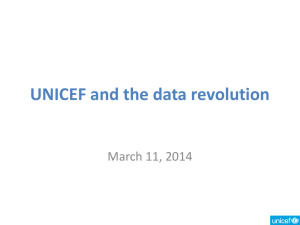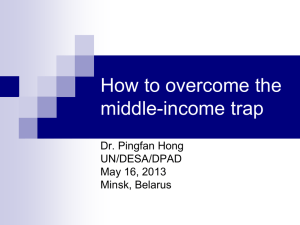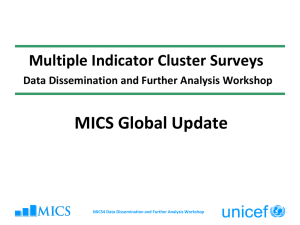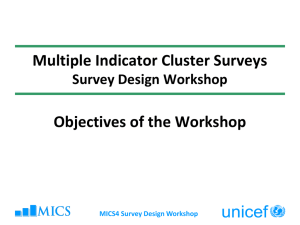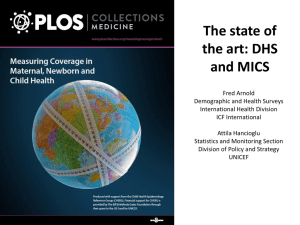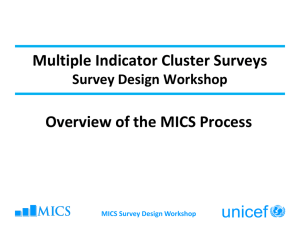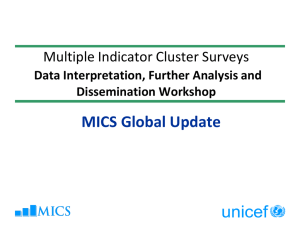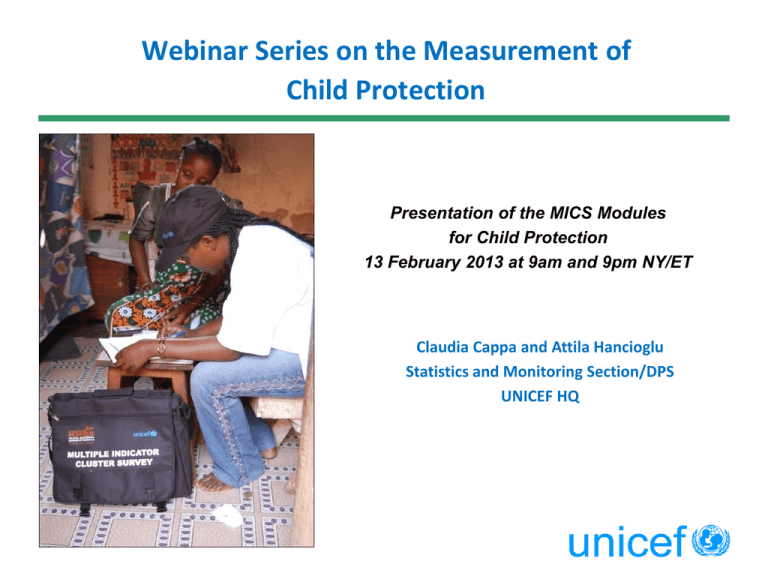
Webinar Series on the Measurement of
Child Protection
Presentation of the MICS Modules
for Child Protection
13 February 2013 at 9am and 9pm NY/ET
Claudia Cappa and Attila Hancioglu
Statistics and Monitoring Section/DPS
UNICEF HQ
Outline
• Discuss some conceptual, methodological,
ethical challenges related to the collection of
data on child protection through household
surveys
• Provide an overview of the MICS survey
program
• Review existing Child Protection Modules in
MICS
Some preliminary questions
• Why do we need data/evidence?
• What data/evidence do we need?
• What data/evidence do we have?
• How can we make be better use of what we have?
• How should we get the data/evidence we need?
What data/evidence do we need?
• Prevalence data on nature and magnitude of CP violations
• Risk and protective factors
• Evidence on how and why certain violations occur and
persist
• What works and what does not work for prevention and
response
• Data and information for the monitoring and evaluation of
programmes
Main sources of data for CP
Nationally representative household surveys (part of international
programs)
Relevant to obtain prevalence estimates; not suitable for understanding why
Use standard data collection methodology and questionnaires to allow for
country/regional comparisons and trend analysis
Primary sources of disaggregated data
Typically, data are collected by countries every 3-5 years
“KAP surveys”= Problem with standardization and validation
School-based surveys = Population of children out of school
Administrative data, Census
Special methods are needed to capture certain populations
Multiple Indicator Cluster Surveys
Multiple Indicator Cluster Surveys
• Household survey program, developed by UNICEF
in the 1990s
– to assist countries in filling data gaps on children’s and
women’s well-being for tracking progress toward World
Summit for Children Goals
• Nationally representative household sample
surveys
– Face to face interviews, observations, measurements
– Representative sample of households
MICS 1995-2014
Round
Year/Period
Emphasis
MICS1
1995
World Summit for Children Goals
62
MICS2
2000
World Summit for Children Goals
65
52
60
MICS3
2005-2007
World Fit For Children Goals, MDGs,
Other Global Monitoring
Frameworks
MICS4
2009-2012
MDGs, Other Global Monitoring
Frameworks
2013-2014
Final MDG Assessment, A Promise
Renewed, Other Global Monitoring
Frameworks
MICS5
No. of Surveys
40 +
MICS Implementation
UNICEF develops standard tools,
guidelines
Countries customize survey tools
Technical support and training
Governments conduct surveys
Implementing agencies conduct analysis,
produce reports, disseminate
Public sharing of reports and micro data
In collaboration with interagency groups,
UNICEF, other stakeholders, DHS
programme
With UNICEF support, through regional
workshops, in-country support
Funding support primarily by UNICEF, plus
other agencies – USAID, UNFPA and
others
By governments and UNICEF
• Full government ownership
• Use globally agreed-upon indicators as starting point, design survey tools
around these indicators
MICS4 Surveys by Region
14
12
12
10
11
Number of Surveys
10
8
8
7
6
7
5
4
2
0
CEECIS
East Asia
Pacific
Eastern-Southern
Africa
Middle East
North Africa
South
Asia
Latin America
Caribbean
Western-Central
Africa
• Low and middle/high income countries
•Chad, Mali, Costa Rica, Serbia, Qatar, Argentina
• Emergency or post-emergency settings
•Somalia, Iraq, Sindh, Sudan
• New to MICS (Bhutan, Mali), all MICS rounds
(Serbia, Gambia), “returning” countries
(Moldova, Afghanistan)
• Single household survey data source on
children in several countries
Questionnaires – Some Features
Factual questions, behavior – some attitude
questions
Validated and tested questions/modules
All questions contribute to either the numerator
or denominator of a well-defined indicator
Indicators are mostly those adopted and
endorsed by the international community
MDGs, interagency indicator sets, other international
commitments
Features
Sampling
Multi-stage stratified cluster samples
Sample size (MICS4): Around 10,000 households, but huge
variation
Over-sampling of households with under-5s
Fieldwork
2-4 months
Supervisor, field editor, measurer, 3 to 5 interviewers
Training
3 weeks, including field practice
Reporting
Summary Findings Report
Final Report – 12 months after completion of fieldwork
Technical assistance
Regional workshops, regional MICS coordinators, regional
household survey experts
Access
www.childinfo.org
Reports and micro data sets (SPSS)
Questionnaires and Topics
• Household Questionnaire
– Usual members of households
• Women’s Questionnaire (Age 15-49)
– With Birth Histories
– Without Birth Histories
• Men’s Questionnaire (Age 15-49)
– Usually for a sub-sample
• Under-5 Questionnaire
– Administered to mothers or primary caretakers of under-5s
HOUSEHOLD QUESTIONNAIRE
WOMEN’S QUESTIONNAIRE
social & demographic characteristics
child mortality
living arrangements
maternal mortality
education
antenatal, delivery & postnatal care
water and sanitation, hand washing
contraception/unmet need
household assets
female genital mutilation/cutting
ITNs
WOMEN’S AND MEN’S QUESTIONNAIRES
child labour
attitudes toward domestic violence
child discipline
marriage
salt iodization
sexual behaviour
child disability
HIV/AIDS knowledge and attitudes
access to mass media and use of ICT
tobacco and alcohol use
UNDER-5 QUESTIONNAIRE
life satisfaction
birth registration
early childhood development
diarrhoea, pneumonia, malaria
immunization
infant and young child feeding
anthropometry (nutrition indicators)
MICS strategy
for inclusion of new topics
•
•
•
•
•
•
•
Global relevance
UNICEF priority
Programmatic relevance
Validated, tested
Economical and simple
Maintain eligibility, general structure
Avoid further sophistication
MICS 2013-2014
Timelines
• Global Pilot Survey (Bangladesh, May-June 2012, 1000
households)
• Official launch by UNICEF (October 2012)
• Finalize survey instruments
• …and supporting documents (by March 2013)
• Workshops: March 2013 onwards
• Survey implementation
– 2013 - First quarter 2014 at the latest for surveys servicing
MDG reporting
– 2013 and 2014 for all other surveys
Timeline for Global Reporting on MDGs
2011
2012
2013
2014
2015
MICS 4
MICS 5
Large number of
countries expected to
conduct surveys for MDG
monitoring
Data compilation and analysis
Summer 2014
Submission of data for SG’s report
March 2015
SG’s MDG Report launch
September 2015
Child Protection Modules in MICS
MICS and Child Protection
Largest source of internationally comparable data on Child
Protection (countries covered, topics)
Groups of children that out of the scope of a household
survey: Children living in institutions, children living on the
street, etc.
Comparison with other surveys
- other non-specialized household surveys (DHS, RHS)
- thematic household surveys (SIMPOC, VAC)
- school based-surveys (GSHS, HBSC)
Child Protection Modules in MICS
•
•
•
•
•
•
Birth Registration
Child Labour
Child Discipline
Child Marriage
Attitudes towards Domestic Violence
FGM
Other relevant cross-cutting issues
• Living arrangements
• Child Disability
• Children in Child-Headed Household
MICS countries that collected data on CP
UNICEF
region
FGM/C
Marriage
Attitudes
towards
Domestic
Violence
Child
Discipline
Birth
Registration
Child
Labour
CEECIS
0
13
11
11
13
13
EAPRO
0
5
3
3
6
4
ESARO
1
3
1
0
2
1
MENARO
2
10
2
9
11
7
ROSA
0
1
0
0
1
1
TACRO
0
5
5
5
6
5
WCARO
11
12
9
9
13
9
TOTAL
14
49
31
37
52
40
Birth Registration
Questionnaire
BIRTH REGISTRATION
BR1. DOES (NAME) HAVE A BIRTH CERTIFICATE?
BR
Yes, seen
Yes, not seen
No
DK
1
2
3
8
1NEXT
MODULE
2NEXT
MODULE
BR2. HAS (NAME)’S BIRTH BEEN REGISTERED WITH THE CIVIL
AUTHORITIES?
Yes
No
DK
1
2
8
1NEXT
MODULE
BR3. DO YOU KNOW HOW TO REGISTER YOUR CHILD’S BIRTH?
Yes
No
1
2
IF YES, ASK:
MAY I SEE IT?
MICS Indicator
Numerator:
• Number of children under age 5 whose births are
reported registered
Denominator:
• Total number of children under age 5
Child Labour
Questionnaire
• New module developed in consultation with ILO
• Background data analyses to establish sensitivities of
questions to CL prevalence
• Progress towards harmonization of data collection
tools, but significant differences remain with SIMPOC
and ILO estimates
• New age group 5-17
• Three components: economic activities, hazardous
working conditions and household chores
Child Labour – MICS Indicators
• Percentage of children 5-17 years of age involved in child
labour
Age 5–11 years: At least 1 hour of economic work or 28 hours of
domestic work per week
Age 12–14 years: At least 14 hours of economic work or 28 hours of
domestic work per week
Age 15-17: At least 43 hours of economic work or domestic work per
week
•
Percentage of children 5-17 years of age working under
hazardous conditions
Child Discipline
Child Discipline Module
• Questions addressed to family relatives/mothers or primary
caregivers of one randomly selected child aged 2 to 14 years old
• The questionnaire asked whether any member of the household
had used any of various disciplinary practices with that child during
the past month
• 8 violent disciplinary practices: 2 psychological (such as shouting
and name calling); 6 physical (such as shaking, spanking and hitting
with an implement)
• 3 non-violent disciplinary practices (such as taking away privileges
and explaining why something is wrong)
• Assesses respondents’ attitude toward physical punishment
Violent Discipline Indicator
• Numerator:
Children age 2-14 years who
experienced any violent discipline (psychological
aggression or physical punishment) during the 30
days preceding the survey
• Denominator: Children age 2-14
Child Marriage
MICS Indicators
• Marriage before age 15: Proportion of women age 15-49 years who
were first married or in union by the exact age of 15
• Marriage before age 18: Proportion of women age 20-49 years who
were first married or in union by the exact age of 18
• Young women age 15-19 years currently married or in union
• Polygyny: Proportion of women age 15-49 years who are in a
polygynous union
• Spousal age difference: Proportion of women currently married or in
union whose spouse is 10 or more years older (a) for women age 15-19
years, (b) for women age 20-24 years
Attitudes towards domestic violence
Background
• Collecting and analyzing information on the reasons why wife beating
is justified makes it possible to under gender attitudes towards the
female roles of wife, mother, and domestic partner
• Measurement of practices of violence against women, although
possible, raise ethical and methodological issues
• Positive attitudes towards domestic violence have been found to be
associated with the prevalence of domestic violence; still many
women justify domestic violence even if they have not been victims
• Positive attitudes do not necessarily signify approval by women of
wife-beating, but they signify women’s acceptance of such norms
MICS Indicator
Percentage of women aged 15-49 who state that a
husband/partner is justified in hitting or beating his
wife in at least one of the following circumstances:
–
–
–
–
–
(1) she goes out without telling him
(2) she neglects the children
(3) she argues with him
(4) she refuses sex with him
(5) she burns the food
Female Genital Mutilation/Cutting
Innovations in data collection
• Change in the questionnaire for daughters: new
questionnaire allows for calculating prevalence for age group
0-14
• Most surveys conducted before 2010 and some of the 2010
surveys asked women about the FGM/C status of only one
daughter, either the first born, or the most recently cut
• Changes introduced in MICS 4 (2010-2011) and adopted by
DHS surveys as well
Rationale and methodological
considerations
• Prevalence rates can provide an enhanced understanding of FGM/C
among the youngest age groups where recent intervention efforts would,
in many settings, show the most impact
• However, girls 0-14 may still be exposed to the risk of being circumcised
depending on the age at which FGM/C is generally performed (censored
observations)
• Importance of taking age at cutting into account
• As age at cutting varies in different settings, the amount of censoring will
vary
• Caution is needed when comparing across age cohorts and across surveys
Module
Three sets of questions:
1) Questions for women 15-49 years of age:
Knowledge of the practice
If FGM/C has happened to her
Type of procedure: if flesh was removed, nicked without removing
flesh, sewn closed
Age of circumcision
Performer: traditional performer, health personnel
2) Questions for FGM/C for daughters (0-14):
Circumcision status of all daughters below age 15
Type of procedure
Age of circumcision
Performer: traditional performer, health personnel
3) Attitudes regarding the continuation of the practice
MICS Indicators
•
Approval for FGM/C
Number of women age 15-49 years favouring the continuation of female genital
mutilation/cutting (FGM/C)/Total number of women age 15-49 years who have
heard of FGM/C
•
Prevalence of FGM/C among women
Number of women age 15-49 years who report to have undergone any form of
female genital mutilation/cutting (FGM/C)/Total number of women age 15-49
years
•
Prevalence of FGM/C among girls
Number of girls age 0-14 years who have undergone any form of female genital
mutilation/cutting (FGM/C), as reported by mothers/ Total number of girls age 014 years
THANK YOU
43

